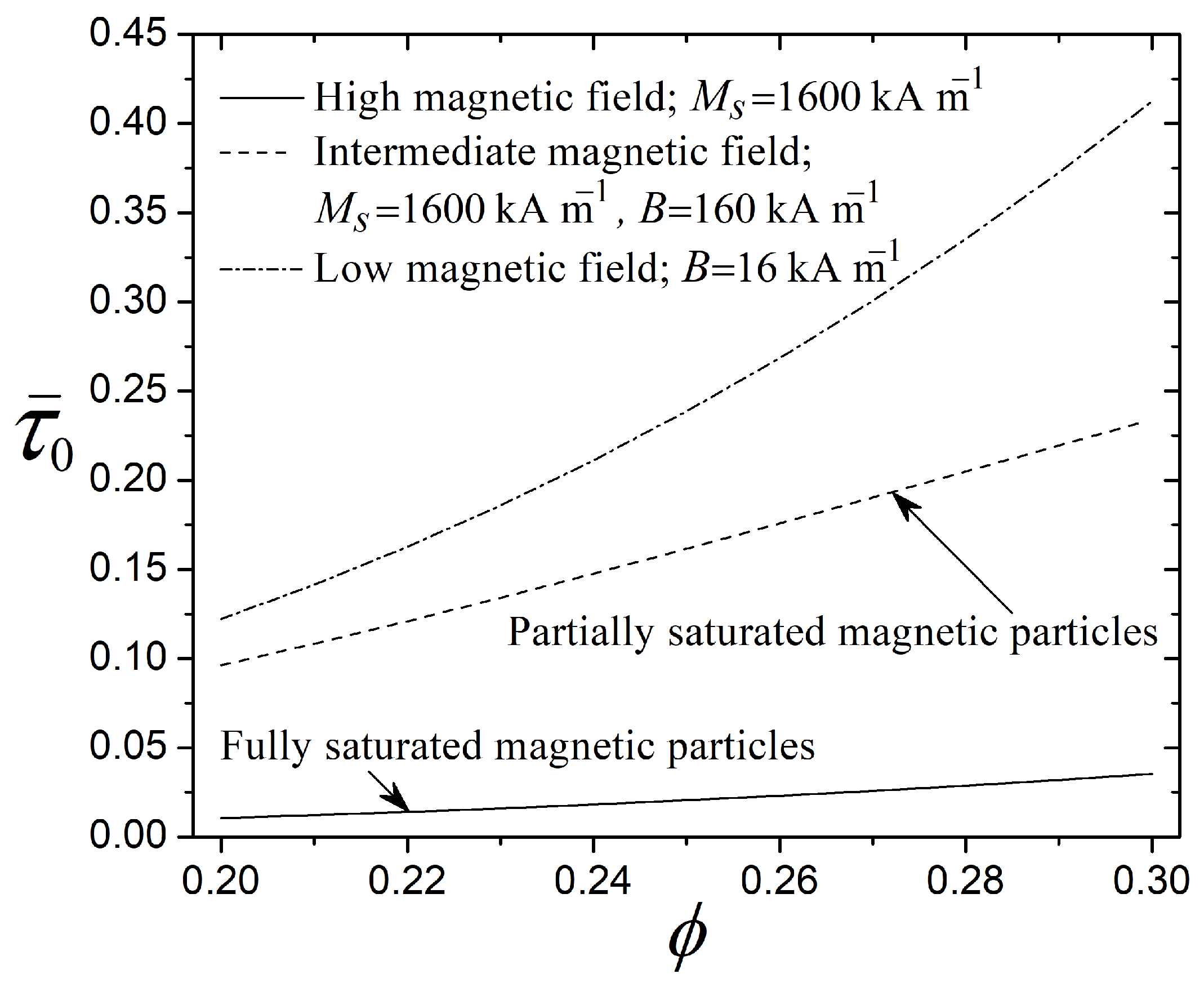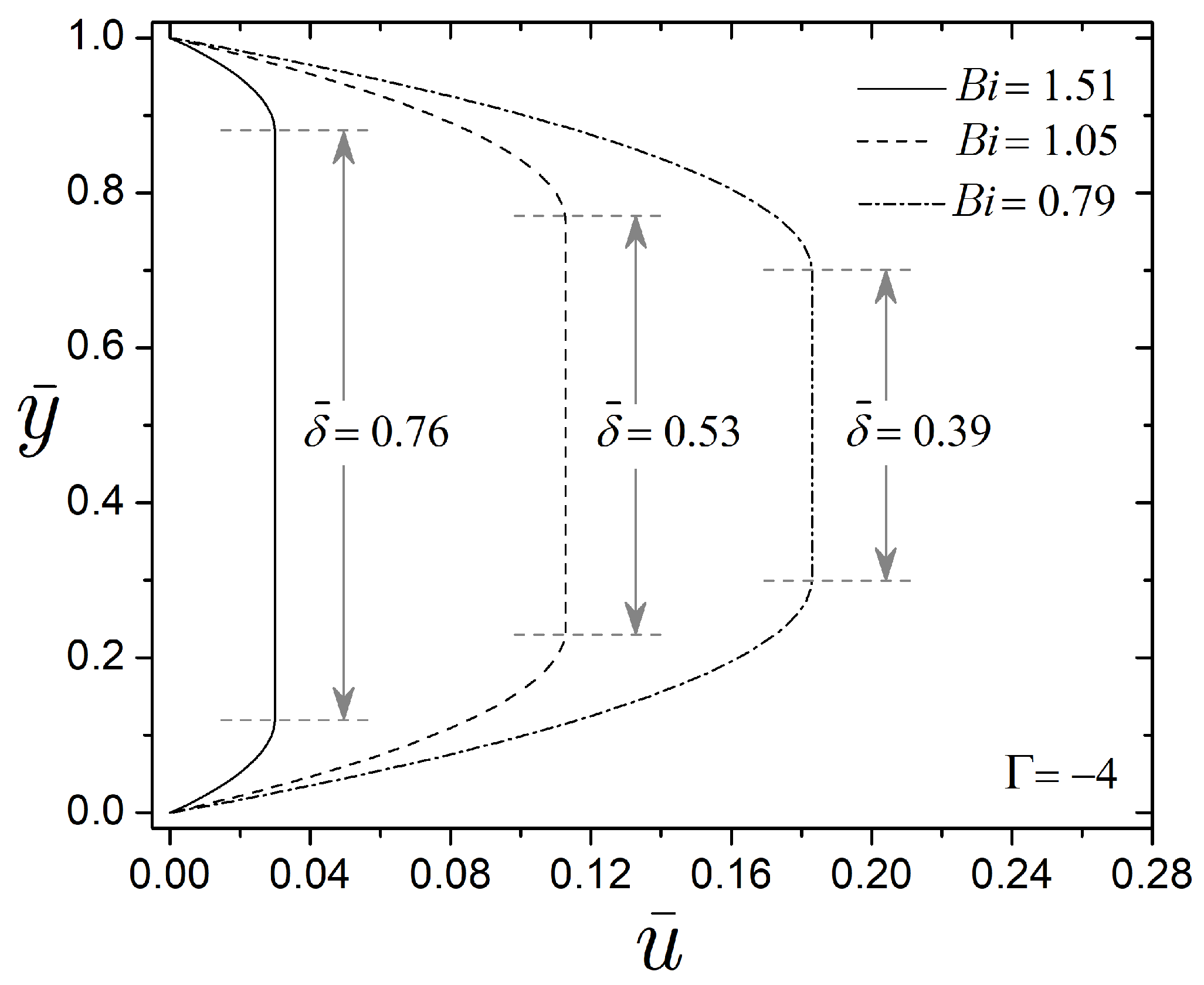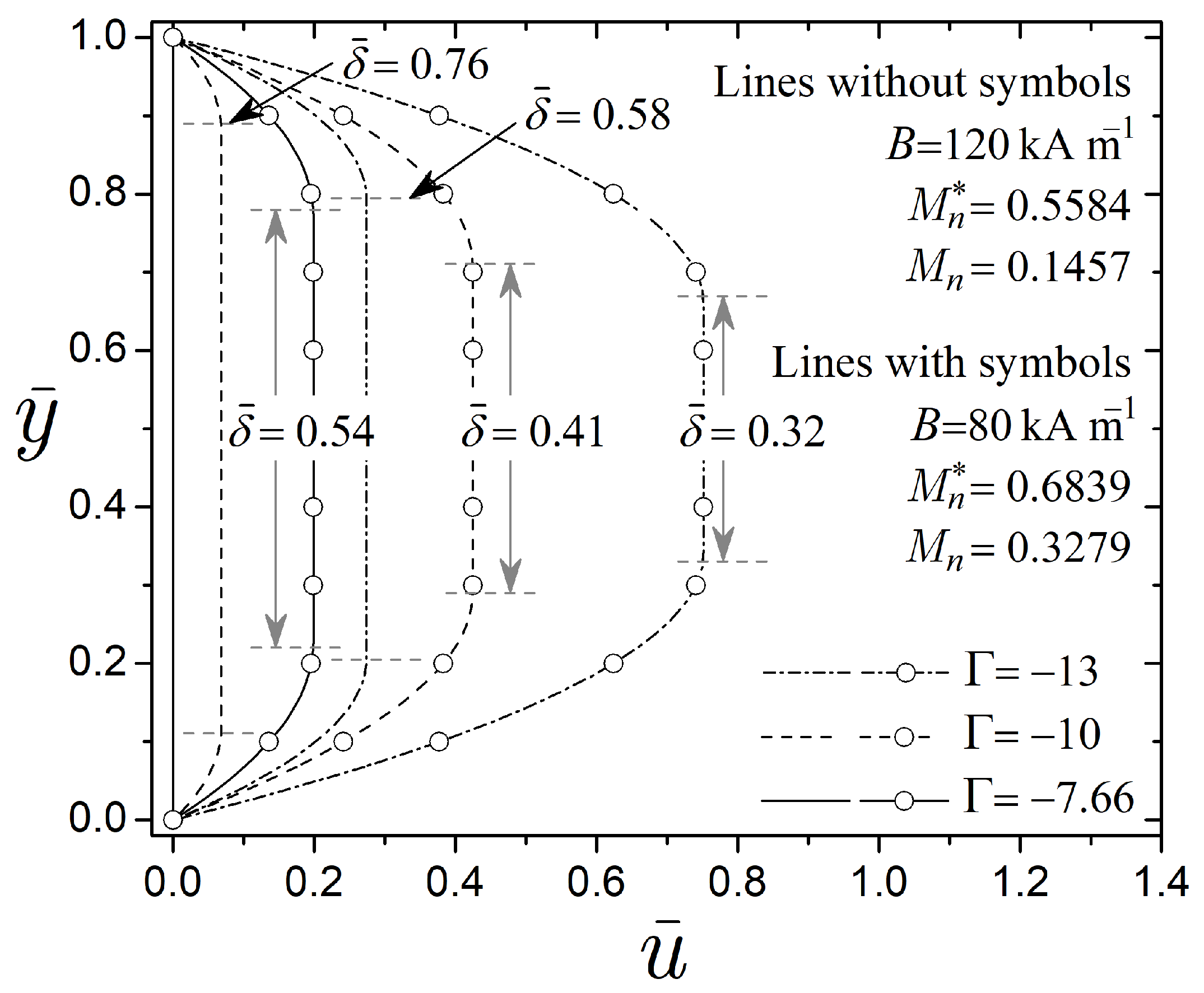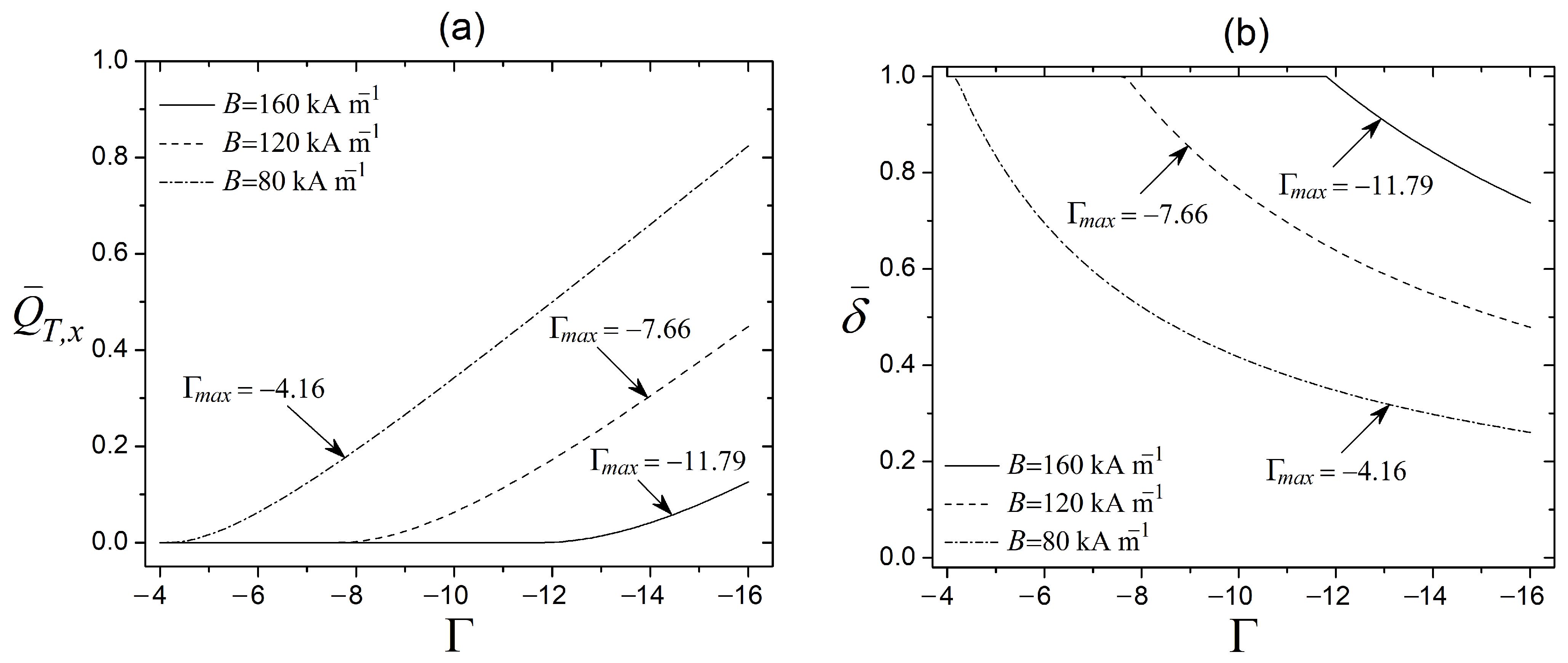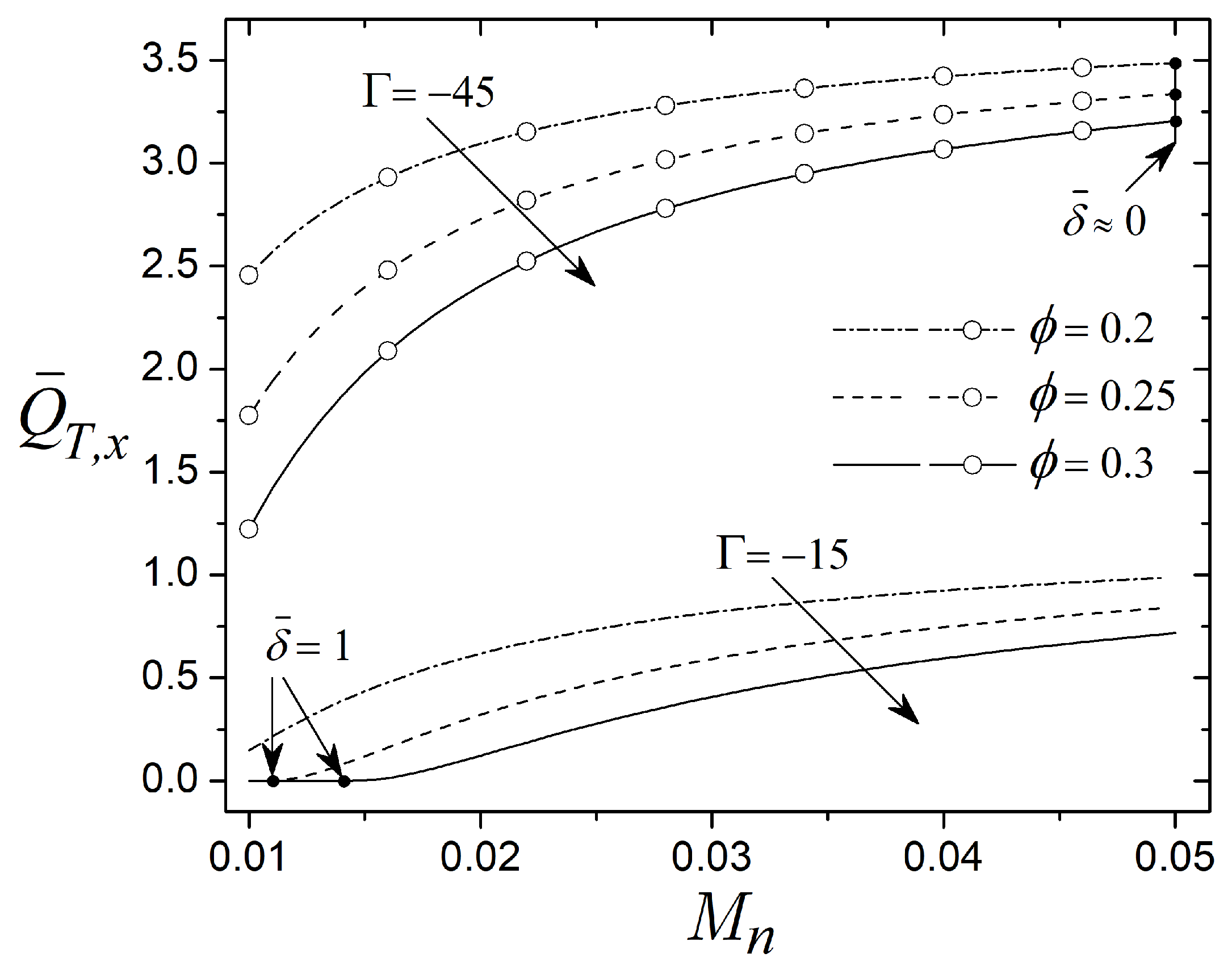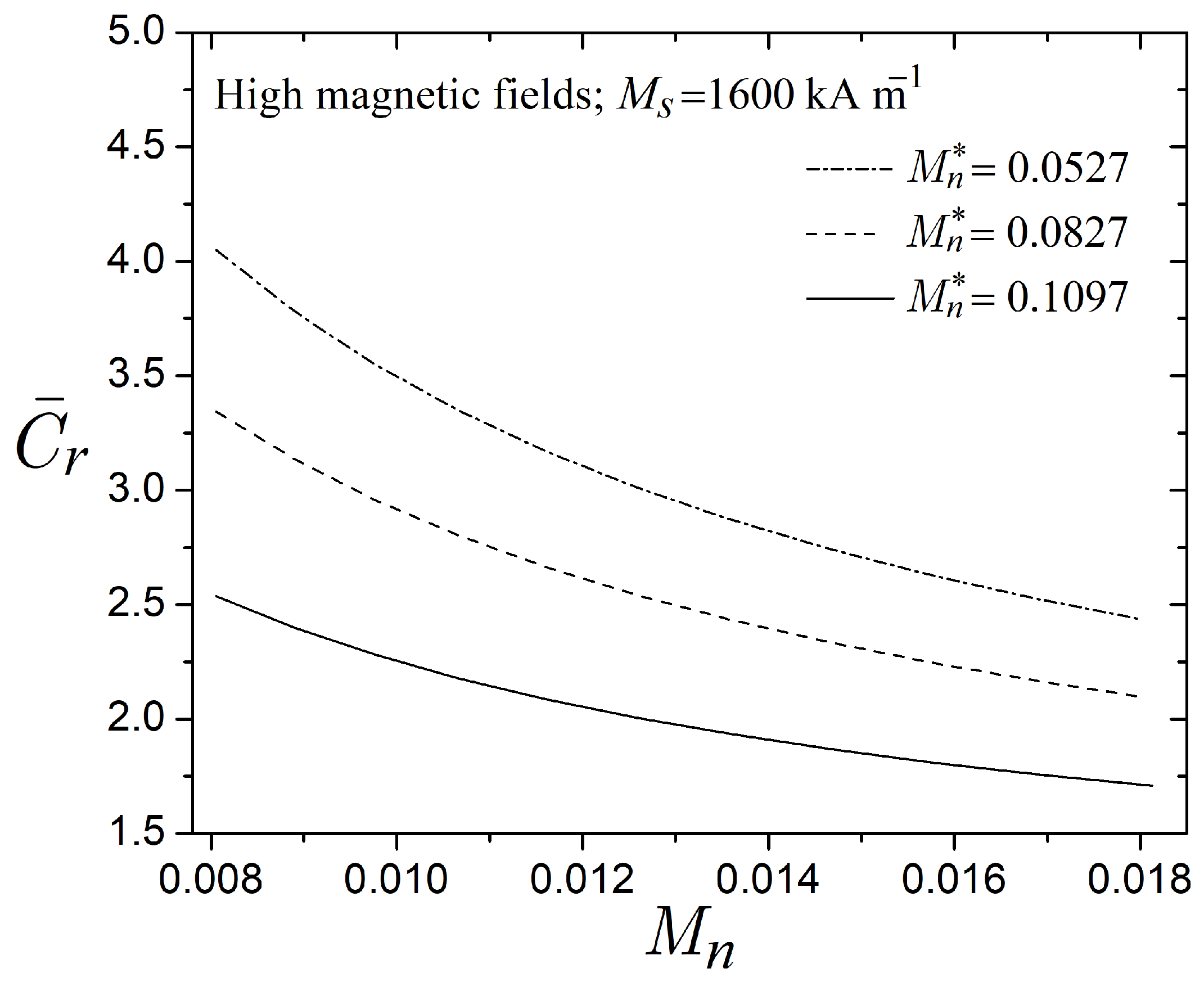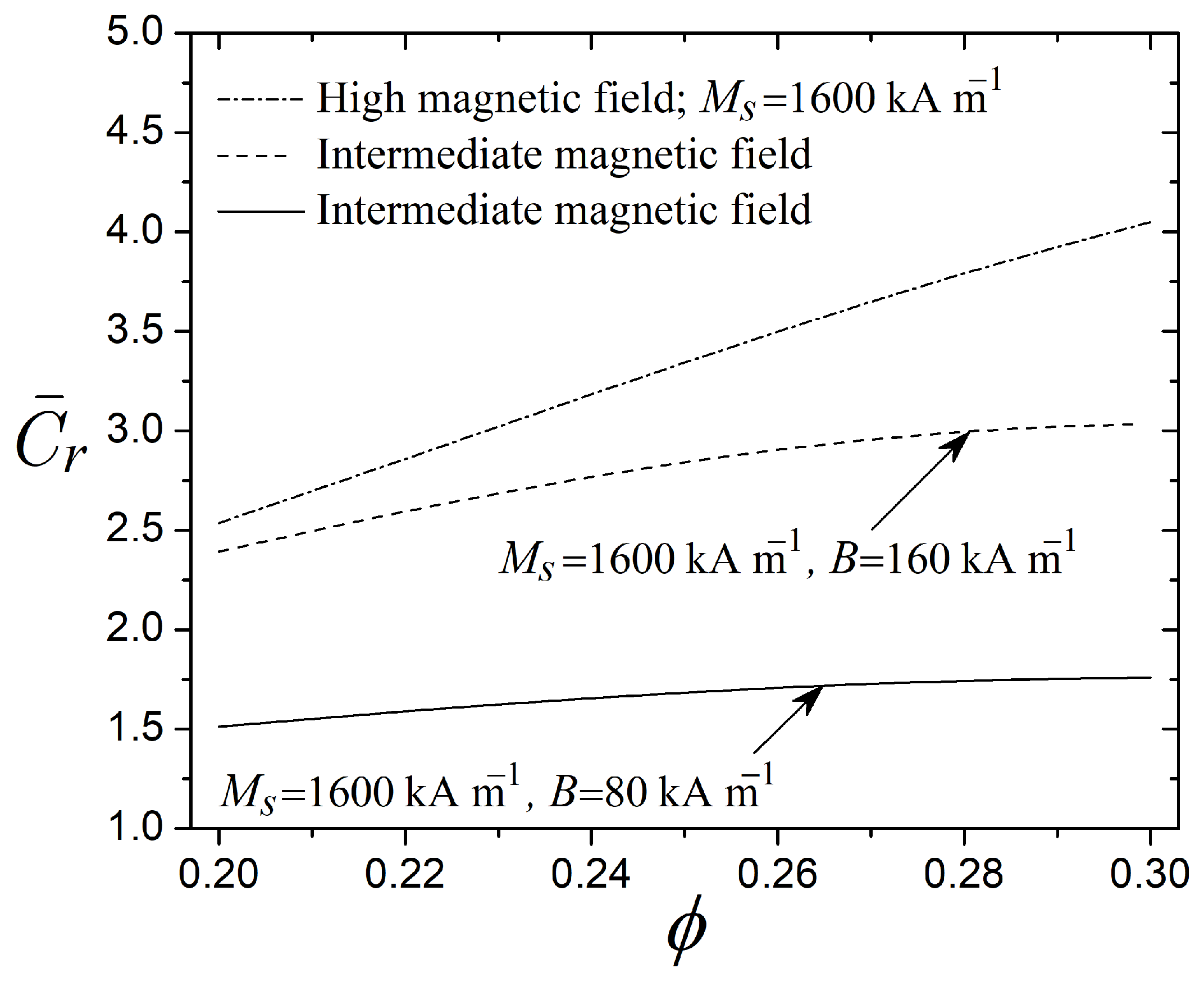5.2. Criteria for Estimating Dimensionless Parameters
Magnetic particles dispersed in the carrier fluid control the properties of the MR fluid in
Figure 3. This figure illustrates the effect of adding hard spherical particles to the carrier fluid on the viscosity ratio and effective permeability of the MR fluid, considering the range of
for typical MR damper applications. It is important to consider that, for high particle concentrations above
, the MR fluid can acquire the behavior of a solid paste, complicating fluid manipulation [
2]. Conversely, in the absence of magnetic particles
, the MR fluid recovers the viscosity of the carrier fluid
according to Equation (
28). Thus, in
Figure 3, the field-independent viscosity of the MR fluid increases by incorporating particles into the carrier fluid, reaching the highest viscosity of
when
. Furthermore, the MR fluid obtains viscosities of
and
Pa s when
and
, considering a particular carrier fluid viscosity of
Pa s (silicone oil) [
27]. This increase in
represents an increase in viscosity of the MR fluid of
when
and
when
compared to the initial viscosity of
Pa s. In this context, the results in
Figure 3 enable the evaluation of the Mason number or the Bingham number, assuming that the increase in viscosity contributes to the hydrodynamic stress. On the other hand, in the inset of
Figure 3, the particle volume fraction
also modifies the effective permeability of the MR fluid (
in
Section 2.2), taking as a reference that
[
31,
38]. According to the previous equation, the parameter
provides the magnetic characteristics of the MR fluid, considering that the carrier fluid is non-magnetic;
when
, while
and
when
and
, respectively. Therefore, because the effective permeability is associated with the magnetization of the MR fluid, the fluid exhibits greater magnetic susceptibility as particle concentration increases, resulting in more significant magnetic stress (see
Section 2.2). Also, the increase in magnetic particles modifies the capacity of the MR fluid to form chain-like structures when a magnetic field is applied, affecting the damping force that regulates flow through the valve.
Another aspect to consider is that the MR fluid subjected to a magnetic field acquires the behavior of a semi-solid with a certain yield stress. This fluid condition is due to the alignment of particles in the direction of the magnetic field, resulting in chain-like structures that inhibit fluid motion.
Figure 4 estimates the dimensionless yield stress
for different particle volume fractions
and magnetic fields
B, considering hard spherical particles (
μm) of iron with
kA m
−1 [
41]. Here, the parameter
exhibits the ratio of the yield stress
to the magnetic stress
(magnetic attraction force between particles), comparing the reference mechanical resistance of the MR fluid at macro and micro scales [
28]; see
Section 3. For low magnetic fields, the magnetization of the MR fluid is proportional to
(see Equation (
6)). Carlson and Jolly [
11] report that MR fluids exhibit approximately linear magnetic properties up to an applied field of about
kA m
−1 in this regime, while for intermediate magnetic fields, the magnetization of the MR fluid scales nonlinearly with
(see Equation (
7)). Finally, for high magnetic fields sufficient to achieve the saturation point, the yield stress is field-independent and proportional to
(see Equation (
8)). In
Figure 4, the magnetic stress (
) scales with the average magnetization of particles (
), which is generally larger than the magnetization of the MR fluid (
). As a result, the magnetic stress exceeds the yield stress in all cases (
), and thus
. Moreover, the parameter
at a high magnetic field is lower than
at a low magnetic field due to the nonlinearity of the magnetization. Here,
and
when
and
with the low magnetic field (
kA m
−1), while
and
when
and
with the high magnetic field (
kA m
−1). Therefore, these results demonstrate that increasing
from
to
(either for low, intermediate, and high magnetic fields) enhances the fluid resistance, assuming that the field-responsive effect of the MR fluid depends on the concentration of magnetic particles. Also, the most significant change in the dimensionless yield stress due to the increase in particle volume fraction occurs at the low magnetic field (
kA m
−1).
In the evaluation of the dimensionless parameters in this work, it is clear that the magnetic field strength contributes to the formation of particle chain-like structures, thereby increasing the MR fluid resistance. Nevertheless, magnetic particles experience viscous drag due to the pressure drop across the control valve. In this context, the dimensionless Mason number
determines the competition between magnetostatic and hydrodynamic forces at the microscopic level, which establishes the pre-yield thickness of the MR fluid.
Figure 5a shows the Mason number (see Equation (
11)) as a function of the magnetic stress
(see Equation (
9)) for different values of the particle volume fraction
and three intermediate magnetic fields
B, considering a carrier fluid viscosity of
Pa s and a strain rate of
= 12,000 s
−1 to estimate the hydrodynamic stress. In general, the Mason number decreases as the magnetic field magnifies the magnetic stress according to Equations (
9) and (
11), indicating that magnetic forces govern the microscopic behavior of the MR fluid. Meanwhile, the increase in magnetic particles reduces both the average magnetization of particles
and the magnetic stress
, increasing the Mason number. It is important to establish that the equilibrium between magnetic and hydrodynamic forces occurs when
[
2]. Once the hydrodynamic forces equal or exceed the magnetic forces
, the MR fluid acts as a purely liquid layer [
2,
32].
On the other hand, assuming that the ratio of magnetic and viscous forces scales linearly from the microscopic to the macroscopic level, the Mason number is inversely related to the Bingham number. With the above, a relevant feature in the design of MR fluid-based devices is the critical Mason number
, which determines the formation and collapse of particle chain-like structures [
28]. Therefore,
Figure 5b evaluates the critical Mason number from
Figure 5a, which depends only on the dimensionless yield stress
and viscosity ratio
. Typically, the critical Mason number follows the behavior of the Mason number, where
increases as the magnetic field decreases and the particle volume fraction increases. The critical Mason number is constant and serves as a transition measure between the Mason number and the Bingham number
. Above the critical Mason number
, the chain-like structures will not be able to form since the viscous drag on the MR particles prevents them from agglomerating together [
2]. Usually, the critical Mason number is low; for high magnetic fields, the parameter
is of the order of
. Points
, indicate
, respectively, and are selected for further analysis in
Figure 6.
Figure 6 evaluates the Bingham number
as a function of the Mason number
and three values of the critical Mason number
. Here,
,
, and
are extracted from
Figure 5b, considering points
,
, and
. Meanwhile, the range of
is extracted from
Figure 5a for the case of
kA m
−1. To recover the range of
through the magnetic fields of
and 60 kA m
−1, the strain rate
in the Mason number calculation must be less than 12,000 s
−1. In this context, the limits of
and
ensure the formation of particle chain-like structures that result in the solid region of the MR fluid, which is essential to control flow through the valve. The dimensionless Bingham number establishes the ratio of magnetic stress to viscous stress and scales with
.
The field-responsive effect of the MR fluid increases as the Bingham number rises, indicating that the magnetic field modifies its properties. This behavior implies that the microscopic characteristics of magnetic particles dispersed in the carrier fluid significantly influence the performance of the MR fluid. The critical Mason number
is constant and manifests the changes in yield stress and viscosity due to the addition of magnetic particles in the carrier fluid. In this sense, the Bingham number increases in all cases in response to an increase in
. The results in this section show the MR fluid response to the magnetic field, which serves as a reference to estimate the dimensionless parameters required to analyze the control valve. These evaluations reveal the mechanical resistance of the MR fluid at the macroscopic level, considering its microscopic characteristics associated with the formation of chain-like structures that inhibit fluid motion. Points
are selected for further analysis in
Figure 7.
5.3. Velocity Profiles and Flow Rates
This section presents the hydrodynamic behavior of the MR valve in terms of dimensionless parameters, considering the effects of intermediate and high magnetic fields on the MR fluid. This study seeks to highlight the qualities of the MR fluid in regulating flow through the control valve, assuming the nonlinearity of particle magnetization that depends on the magnetic field strength.
Figure 7 shows the velocity profiles for
,
, and
extracted from
Figure 6. To simulate the performance of the MR fluid through the control valve, a pressure gradient of
drives the fluid volume from the rebound chamber to the compression chamber in
Figure 1a. The negative sign indicates the flow on the positive
x-axis, which occurs when the piston rod leaves the cylinder. The thicknesses of liquid and solid regions depend on the competition between the fluid resistance, as measured by the Bingham number, and the shear stress due to the pressure gradient. In the absence of a magnetic field strength (
), the MR fluid behaves as a completely liquid layer. On the contrary, increasing the Bingham number (
) reduces the thickness of liquid layers and generates a solid layer at the center of the channel. This solid layer represents the particle chain-like structures that are not broken. Here, the dimensionless pre-yield thickness is determined by Equation (
50), resulting in
and
for each value of
and 0.79. The MR fluid can withstand a certain load before deforming. The maximum pressure gradient
applied to the fluid before liquid regions appear is determined by Equation (
50), considering
(completely solid layer) and assigning
instead of
. Therefore, the valve remains closed in all cases when
. Once
exceeds
, the valve opens, as in
Figure 7, where
holds since
and
for
, respectively.
Figure 8 presents the velocity profiles as a function of the transverse coordinate
and different pressure gradients
, where the velocity profiles represent the flow field through the annular gap in the active region of the MR valve, and the pressure gradient results from the piston movement. This figure illustrates the hydrodynamic response of the MR fluid under two magnetic fields to regulate flow in the valve. In this context, the results are evaluated with
,
Pa s,
s
−1, and intermediate magnetic fields from Equation (
7) with
kA m
−1. Furthermore, the velocity profiles exhibit a mechanical resistance (via the Bingham number) of
for the lines with symbols and
for the lines without symbols. Also, the magnetic stress is greater than the hydrodynamic stress in all cases of this figure, and thus
and
. In the velocity profiles without symbols, the MR fluid withstands a compression force of
. Therefore, the valve remains closed until the pressure gradient
applied to the flow exceeds
, as in the equilibrium condition of the velocity profile without flow (solid line without symbols, where
). Meanwhile, the valve opens when
, as for the dashed lines without symbols corresponding to
and
, which lead to pre-yield thicknesses of
and
, respectively. On the other hand, decreasing the magnetic field from
kA m
−1 to
kA m
−1 reduces the fluid resistance from
to
in the velocity profiles with symbols. This result implies that the velocity profiles with symbols offer less resistance to deformation than those without symbols. The velocity profiles with symbols include certain liquid regions, considering that in all cases,
. Here, the pre-yield thicknesses are
,
, and
for
,
, and
, respectively. When comparing the pre-yield thicknesses of the velocity profiles with and without symbols against the pre-yield thickness of the fully closed valve (
), the reduction in the magnetic effect on the MR fluid from
kA m
−1 to
kA m
−1 leads to a valve opening of
to
when
,
to
when
, and
to
when
. In this comparison, liquid regions establish the valve opening percentages.
Figure 9 illustrates the velocity profiles as a function of the transverse coordinate
and different values of the Mason number
and the particle volume fraction
. In this figure, the Mason number represents the formation and collapse of particle chain-like structures in the active region of the MR damper when a magnetic field is applied. Additionally, the Mason number analysis in the behavior of the valve also shows the competition between the fluid resistance that leads to the valve closing and the piston motion that opens the valve. The flow hydrodynamic assumes that magnetic particles, which are dispersed in a carrier fluid with viscosity
Pa s, saturate at a high magnetic field. Hence, the yield stress
is calculated from Equation (
8), considering a saturation magnetization of
kA m
−1. Meanwhile, a high strain rate of
= 12,000 s
−1 on the MR fluid generates liquid regions in the flow field. The addition of hard spherical particles to the carrier fluid modifies the physical properties of the MR fluid; increasing
from
to
increases both the fluid viscosity
(see
Figure 3) and the yield stress
(see
Figure 4). In this sense, the critical Mason number
, which represents the influence of
on the carrier fluid, can capture the above behaviors. For a high and constant magnetic field, the flow field with
and
results in
and
, respectively. Furthermore, in this range of
with
Pa s and
= 12,000 s
−1, the Mason number
varies from
to
. Therefore, the mechanical resistance of the MR fluid (via the Bingham number
), by evaluating
and
with
,
, and
, is
,
, and 5 for
,
, and
in the velocity profiles without symbols (
and
). Meanwhile, the values are
,
, and
for
,
, and
in the velocity profiles with symbols (
and
).
In
Figure 9, the velocity profiles are evaluated with a pressure gradient of
, taking as a reference
, which arises from the combination of parameters that produces the highest resistance (
,
, and
to obtain
). As a result, the velocity profile corresponding to the solid line without symbols lacks liquid regions since
. Then, the increase in hydrodynamic stress (via the Mason number
) in the velocity profiles without symbols from
to
and
reduces the pre-yield thickness from
to
and
. Additionally, comparing the velocity profiles with and without symbols, the reduction in fluid resistance (via the particle volume fraction
) from
to
also reduces the pre-yield thickness from
,
, and
to
,
, and
when
,
, and
, respectively. In particular, the velocity profile with
and
overlaps with the velocity profile with
and
, since both reach the same Bingham number (
). From these results, it is notable that the concentration of magnetic particles in the carrier fluid plays a crucial role in the performance of the MR valve, as increasing the particle volume fraction restricts flow through the valve.
On the other hand,
Figure 10 exhibits the liquid transfer between the compression and rebound chambers in the MR damper for different pressure gradients generated by the piston motion.
Figure 10a complements the results of
Figure 8 by evaluating the dimensionless total flow rate
from Equation (
55), considering different pressure gradients
on the flow field. The dimensionless parameters, such as
,
,
, and
for
kA m
−1, as well as
,
,
, and
for
kA m
−1, are extracted from
Figure 8. Additionally, this figure extends the hydrodynamic analysis by incorporating the magnetic field of
kA m
−1, which gives
,
,
, and
. In the previous values, the parameter
serves as a reference measure to estimate the pressure gradient required to open the MR valve, which occurs when
exceeds
. According to
Figure 10a, the increase in magnetic field strengthens the alignment of magnetic particles that inhibit fluid motion, thereby enhancing the mechanical resistance of the MR fluid. Therefore, the increase in magnetic field from
to 160 kA m
−1 reduces the flow rate, leading to the valve closing. When
, the magnetic fields
, 120, and 160 kA m
−1 produce flow rates of
,
, and 0, respectively. Meanwhile, when
, the magnetic fields
, 120, and 160 kA m
−1 result in
,
, and
, respectively. In this comparison,
kA m
−1 generates substantial flow rates in favor of the valve opening, increasing flow by
when
increases from
to
, while
kA m
−1 induces greater resistance to flow, thus generating lower flow rates than
kA m
−1.
Complementary to
Figure 10a,
Figure 10b presents the dimensionless pre-yield thickness
for different pressure gradients
. In general, the magnetic field enhances the fluid resistance, resulting in thicker solid layers when
B increases from 80 to 160 kA m
−1. Conversely, the increase in
weakens the particle chain-like structure of the MR fluid, reducing the solid region. When
increases from
to
, the pre-yield thickness decreases from
,
, and 1 to
,
, and
when
, 120, and 160 kA m
−1, respectively. These reductions in the solid region reflect an increase in the percentage of the valve opening of
to
,
to
, and
to
when
, 120, and 160 kA m
−1, respectively. Here, the percentage of liquid regions measures the valve opening, assuming that the valve is fully open with
(
) and fully closed with
(
). Therefore, the competition between the fluid resistance and the pressure gradient modifies the pre-yield thickness that inhibits fluid motion, thereby generating interesting behaviors in the valve hydrodynamics.
Figure 11 determines the dimensionless total flow rate
as a function of the Mason number for a flow exposed to a high magnetic field, considering three different particle volume fractions
and two different pressure gradients
. The results show the influence of adding hard spherical particles into the carrier fluid on the hydrodynamic performance of the MR valve. The flow field assumes that magnetic particles dispersed in the carrier fluid saturate at a high magnetic field, considering a saturation magnetization of
kA m
−1. Therefore, the viscosity
and the yield stress
of the MR fluid are field-independent and depend only on the particle volume fraction
; under these conditions, Equations (
28) and (
8) determine
and
, then Equation (
27) establishes the Bingham number
in this figure. In this sense,
and
for
,
and
for
, and
and
for
. Moreover, the driving force for pumping the MR fluid comes from a pressure gradient of
(lines without symbols) and
(lines with symbols). As a result, the Bingham numbers for the pressure gradient
are
for
,
for
, and
for
. Meanwhile, the Bingham numbers for the pressure gradient
are
for
,
for
, and
for
. In both results (
and
), the flow rate
decreases as the particle volume fraction
increases from
to
, reflecting variations in the physical properties of the MR fluid. Also, increases in viscosity
and yield stress
reduce flow, as these parameters are associated with resistance to movement. In this context, the particle volume fraction
can regulate the flow through the control valve by modifying the flow characteristics of the MR fluid. On the other hand, the Mason number
, which indicates the ratio of viscous stress to magnetic stress, also affects the flow rate. For
, the valve remains closed at
, and flow arises as the Mason number increases, indicating an increase in viscous stress. Meanwhile, for
, the highest flow rates occur at
(when
), where the valve is fully open.
5.4. Damping Capacity
This section presents the hydrodynamic behavior of the MR valve, focusing on its damping capacity to regulate flow.
Figure 12 shows the dimensional damping capacity
as a function of the Bingham number
, comparing the solution obtained in this work using Equations (
63), (
66) and (
67) with the following equations extracted from the research developed by Wereley [
22]:
and
where Equations (
71) and (
72) determine the damping capacity as a function of the Bingham number as follows. Equation (
72) evaluates the dimensionless pre-yield thickness
as a function of the Bingham number
in the inset of
Figure 12, where the initial value
produces
and the final value
gives
. Then, Equation (
71) uses each value of
at each position of
to estimate
in
Figure 12. Meanwhile, Equations (
63) and (
66) in this work consider
m
2,
m, and
m to evaluate Equation (
67). Additionally, the range of
appropriately demonstrates the overall performance of both solutions, considering that
reflects a flow condition governed mainly by the pre-yield thickness, according to the work of Wereley [
22]. When both solutions are compared, the overlap between the solid line and the symbols exhibits good performance and convergence of the solution obtained in this research. In
Figure 12, the parameter
is the ratio of the field-dependent damping to the Newtonian viscous damping. When the shear strain rate is very high or the magnetic field is very low, the MR damper recovers the behavior of a passive viscous damper. In this case,
when
, indicating that flow restriction in the valve depends on the channel geometry and fluid viscosity (see Equation (
66) in physical variables, where
).
Conversely, semi-active controllable damping arises by applying a magnetic field to the MR fluid, reducing liquid transfer between the compression and rebound chambers during piston movement. In this figure, increasing the Bingham number
enhances the damping capacity
;
doubles the Newtonian viscous damping (
), and
generates
. Furthermore, the results in
Figure 12 correspond to the dimensionless damper force
, considering that
, where
and
represent the damper force with and without a magnetic field [
22]. Therefore, the parameter
reflects the damper force that the MR valve opposes to the piston movement, thereby regulating flow through the valve.
In
Figure 12, the Bingham number provides a general representation of the damping capacity of the MR valve. However, to explore the effect of adding hard spherical particles to the carrier fluid,
Figure 13 and
Figure 14 evaluate
involving
, which is directly related to the Bingham number
in Equation (
27). Therefore,
Figure 13 presents the dimensionless damping capacity
as a function of the Mason number
, considering different critical Mason numbers
. In this figure, the Mason number
represents the competition between magnetic and hydrodynamic stresses, and the critical Mason number
exhibits the effect of the particle volume fraction
on the viscosity
and the yield stress
. For this evaluation, the reference range
is derived from
with
Pa s,
s
−1, and
kA m
−1. Moreover,
,
, and
result from
,
, and
, respectively. The reduction in
from
to
implies that the magnetic stress increases with respect to the hydrodynamic stress. As a result, the fluid resistance increases as the Mason number decreases, thereby increasing the damping capacity. When
decreases from
to
,
with
increases from
to
, while
with
rises from
to
. Following this trend, the damping capacity benefits from the increase in
(via the critical Mason number) since
with
and
increases by
and
compared to the Newtonian viscous damping (
). Therefore, this evaluation between the critical Mason number and the Mason number provides a general estimate of the performance of the MR valve, considering as a reference measure the competition between magnetic and viscous stresses.
On the other hand,
Figure 14 shows the dimensionless damping capacity
as a function of the particle volume fraction
, considering different magnetic fields. In this figure, Equation (
28) establishes the fluid viscosity
in all cases, while Equations (
7) and (
8) determine the yield stress
for the intermediate and high magnetic fields. Furthermore, the damping capacity
is evaluated with fixed values of
for the high magnetic field, as well as
and
for the intermediate magnetic fields of
and 80 kA m
−1. The above Mason numbers assume as a reference
,
Pa s,
s
−1, and the corresponding magnetic fields. In the absence of magnetic particles
, the damping of the MR valve recovers the Newtonian viscous damping of the carrier fluid. Conversely, when particles saturate at a high magnetic field, the damping capacity of the MR valve increases from
with
to
with
, reflecting an increase in resistance to deformation. Meanwhile, the damping capacities at intermediate magnetic fields are
(
) and
(
) when
kA m
−1, and
(
) and
(
) when
kA m
−1. In the last case, when
B increases from 80 to 160 kA m
−1, the damping capacity increases by
when
and
when
compared to Newtonian viscous damping (
). Also, the increase in the magnetic field magnifies the influence of the particle volume fraction
. When
increases from
to
, the damping capacity at the high magnetic field increases by
, while at intermediate magnetic fields, the damping capacity increases by
when
kA m
−1 and
when
kA m
−1. With these results, it is evident that magnetic particles in the carrier fluid play an essential role in the performance of the MR fluid, enhancing the damping capacity of the valve.



